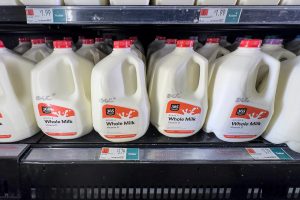
The study found organic farms emit less greenhouse gasses, said Nicole Rakobitsch, the director of sustainability for Organic Valley, a nationwide cooperative of organic farmers based in Wisconsin. Researchers studied the cooperative’s farms to calculate their greenhouse gas emissions.
“It found that our carbon footprint is about 24 percent lower than the U.S. conventional average,” she said. “And that’s due largely to the organic farming practices and the carbon sequestration occurring on Organic Valley farms.”
The study, she said, added up the farms’ carbon emissions and subtracted the amount of carbon they remove from the atmosphere. That carbon sequestration is, in part, due to plants which take carbon from the air to make sugars that are then store it in the soil, she said.
While many conventional farms also use pastures, Rakobitsch said organic farms are required to have 30 percent of their cows’ diet come from the pasture — the average on Organic Valley farms is double that.
With more pasture grasses, organic farms remove more carbon from the atmosphere. And despite growing more plants, organic farms tend to use fewer tractors, Rakobitsch added.
“Because pasture grasses are perennials for the most part — meaning they’re there year over year — so they’re not getting tilled,” she said. “They’re always there growing and recycling that carbon on the farm.”
Another major emitter on conventional farms is manure. Many store manure in a “liquid lagoon,” Rakobitsch said, which releases methane and greenhouse gasses. But according to Rakobitsch, that’s typically not an issue on organic farms.
“Because the cows are out on pasture, depositing their manure as nature intended, right there on the grass,” she said.
Getting more farms to copy these methods could be a key way to reduce greenhouse gas emissions nationwide, said study researcher Horacio Aguirre-Villegas.
“We estimated — depending on the farm layout — anywhere from 10 to 30 percent of carbon levels could be reduced just by changing some practices at the farm level,” he said.
And some, he said, could reduce their emissions even more.
Aguirre-Villegas said he hopes the study will attract the attention of policymakers, provoking them to pressure farms to make these changes, while also understanding the individual economic implications.
“For a farmer that perhaps is struggling to make a living,” he said, “if they have to change something, that change has to be sustainable and profitable.”
While this study is a good first step, he said there still needs to be more research on how farms can reduce their environmental footprint, given agriculture is a major emitter.
“It’s time to acknowledge that there is carbon sequestration potential,” Aguirre-Villegas said, “and that other studies should start including that and improving the methods that we’re proposing.”
Organic milk accounts for over 5 percent of the country’s milk market, with Wisconsin as a key supplier. The state has the second most dairy farms in the country, with over 500 statewide. In 2019, organic dairy sales in Wisconsin totaled over $260 million.

























